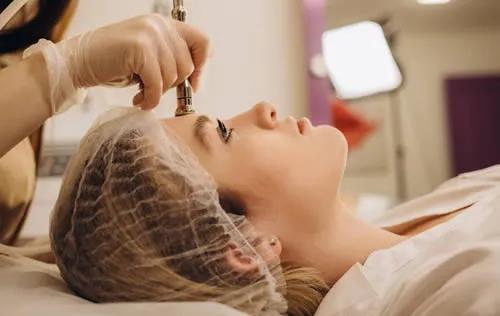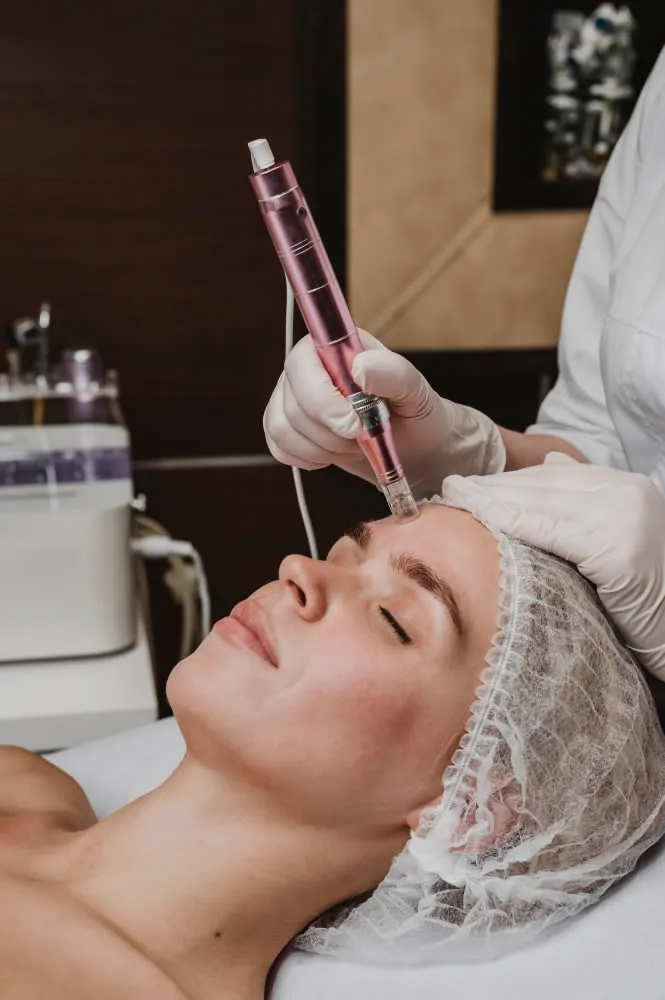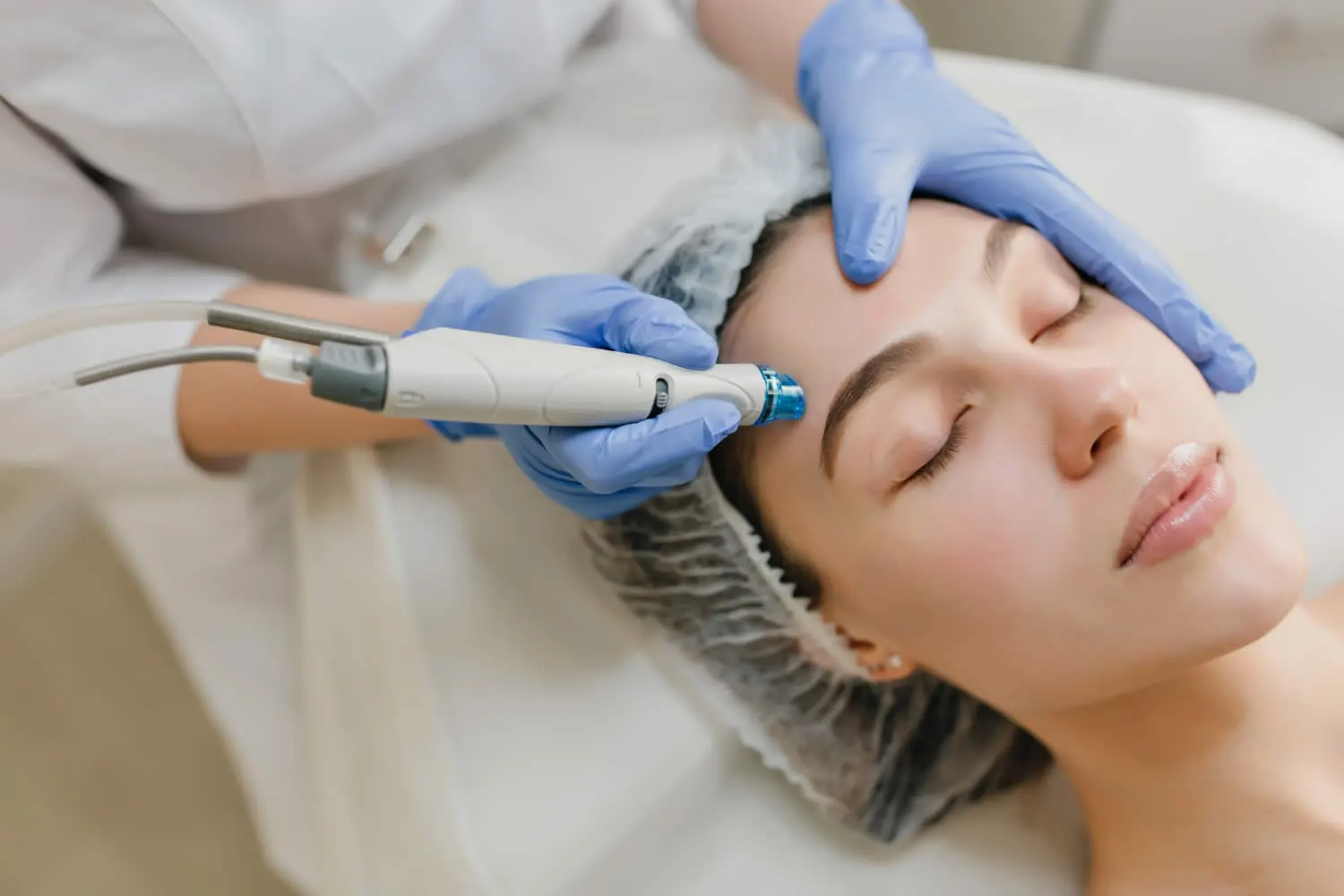What is Dermabrasion?
Dermabrasion is a cosmetic procedure used to improve the appearance of the skin, usually on the face. It involves the use of a specialized instrument, such as a high-speed rotating brush or diamond fraise, to remove the outermost layers of the skin in a controlled manner, revealing smoother, fresher skin underneath.
Dermabrasion is typically used to treat a variety of skin concerns, including acne scarring, fine lines and wrinkles, sun damage, and uneven skin texture or tone. It is also sometimes used to remove tattoos or other skin discolorations.
The procedure itself usually takes about 30 minutes to an hour, depending on the size and location of the treatment area. Prior to the procedure, the skin is typically numbed with local anesthesia, and in some cases, a sedative may also be given to help the patient relax.
After the procedure, the skin may be red, swollen, and tender, and may require several days or weeks to heal, depending on the depth of the treatment. During the healing process, it’s important to protect the skin from sun exposure and to follow any post-treatment care instructions provided by the healthcare provider to ensure optimal results.
Overall, dermabrasion can be an effective way to improve the appearance of the skin and achieve a smoother, more youthful-looking complexion. However, it’s important to have a thorough consultation with a qualified healthcare provider to determine if the procedure is right for you, and to discuss any potential risks, benefits, and alternatives.

How Dermabrasion Works
Dermabrasion is designed to rejuvenate and revitalize your skin by gently removing the outermost layer, revealing a smoother, healthier complexion underneath. Let’s explore how dermabrasion works and why it’s an effective option for addressing a range of skin concerns.
Exfoliation for Renewed Radiance
Dermabrasion operates on the principle of controlled exfoliation. During the procedure, use a specialized device with a rotating abrasive surface. This surface gently scrapes the top layer of your skin, known as the epidermis. This controlled abrasion serves multiple purposes:
- Removing Imperfections: Dermabrasion effectively reduces or eliminates various skin imperfections, including fine lines, wrinkles, acne scars, and uneven skin texture. By exfoliating damaged skin cells, dermabrasion paves the way for healthier skin to emerge.
- Stimulating Collagen Production: The controlled exfoliation triggers your skin’s natural healing response. This includes an increase in collagen production, a crucial protein that provides structure and firmness to your skin. As new collagen forms, your skin becomes smoother and more resilient.
- Enhancing Product Absorption: By removing the outer layer of skin, dermabrasion enhances the absorption of skincare products. This means that after the procedure, your skincare regimen can have a more significant impact, as active ingredients penetrate deeper into the skin.
Benefits of Dermabrasion
Here are some of the key benefits of undergoing a dermabrasion treatment:
- Skin Texture Refinement:
Dermabrasion is renowned for its ability to improve skin texture by gently removing the outermost layer of dead skin cells. This process encourages the growth of fresh, new skin, leading to a smoother and more even skin surface. - Wrinkle Reduction:
By targeting fine lines and wrinkles, dermabrasion can help minimize the appearance of signs of aging. The treatment stimulates collagen production, which contributes to firmer and more youthful-looking skin. - Acne Scar Reduction:
Dermabrasion is particularly effective in reducing the appearance of acne scars. The exfoliation process helps to break down scar tissue and encourage the growth of new skin cells, leading to smoother skin texture. - Hyperpigmentation Improvement:
Uneven skin tone and hyperpigmentation can be significantly improved through dermabrasion. The procedure targets areas of excess pigmentation, revealing a more balanced and radiant complexion. - Sun Damage Reversal:
Exposure to the sun’s harmful UV rays can lead to sunspots, freckles, and uneven pigmentation. Dermabrasion can help fade these sun-induced imperfections, restoring a more youthful appearance. - Enhanced Skincare Product Penetration:
After dermabrasion, the freshly exfoliated skin is more receptive to skincare products. This means that moisturizers, serums, and treatments can penetrate more effectively, maximizing their benefits. - Improvement of Skin Congestion:
Individuals dealing with clogged pores and minor skin congestion can benefit from dermabrasion. The treatment helps clear pores and prevents future breakouts by promoting healthy skin turnover. - Boost in Self-Confidence:
As your skin transforms and becomes more vibrant, you may experience a significant boost in self-confidence. Improved skin appearance often translates to improved overall well-being.
Potential Side Effects of Dermabrasion
While dermabrasion is a safe and effective skin resurfacing treatment, it’s important to understand that like any medical procedure, it may come with potential side effects.
Temporary and Expected Side Effects
- Redness: After a dermabrasion treatment, some redness and irritation are common. This usually subsides within a few days to a week, depending on your skin’s sensitivity.
- Swelling: Swelling, particularly in the treated area, is normal and typically fades within a few days.
- Sensitivity: Your skin may feel more sensitive than usual following dermabrasion. This sensitivity gradually diminishes as your skin heals.
- Peeling and Flaking: As the treated skin heals, you might experience peeling and flaking. This is a natural part of the exfoliation process and reveals the healthier skin beneath.
Less Common Side Effects
While rare, the following side effects can occur:
- Changes in Pigmentation: Some patients might experience temporary changes in skin color, either darker or lighter than their natural tone. This usually resolves over time.
- Scarring: In very rare cases, scarring might occur. This is more likely if proper aftercare instructions are not followed or if the skin is prone to excessive scarring.
- Infection: Although infection is rare, it’s important to keep the treated area clean and follow post-treatment care guidelines to minimize the risk.
Minimizing Risks and Ensuring Your Safety
To reduce the likelihood of side effects and ensure your safety throughout the process, we recommend:
- Strictly Following Aftercare Instructions: Our team will provide you with detailed aftercare guidelines. Following these instructions diligently will promote proper healing and minimize potential complications.
- Avoiding Sun Exposure: Protecting your treated skin from the sun is crucial. Sunscreen with high SPF should be applied daily, and direct sun exposure should be limited.
- Avoiding Irritating Products: During the healing process, it’s best to avoid harsh skincare products or treatments that could exacerbate sensitivity.
Comparing Dermabrasion with Other Treatments
When it comes to achieving smoother, rejuvenated skin, there are several treatment options available. Dermabrasion is a popular skin resurfacing technique, but it’s important to understand how it compares to other treatments to make an informed decision that suits your specific skin concerns and goals.
Dermabrasion vs. Microdermabrasion:
Dermabrasion and microdermabrasion may sound similar, but they are distinct procedures with different levels of intensity. While dermabrasion involves deeper exfoliation of the skin using a rotating tool, microdermabrasion is a milder treatment that uses tiny crystals or a diamond-tipped wand to gently exfoliate the outermost layer of skin. Microdermabrasion is suitable for mild skin concerns and requires minimal downtime, while dermabrasion is better suited for addressing more significant issues and may involve a longer recovery period.
Dermabrasion vs. Chemical Peels:
Chemical peels are another common option for skin rejuvenation. During a chemical peel, a chemical solution is applied to the skin to remove the outer layers, promoting new skin growth. Dermabrasion, on the other hand, involves mechanical exfoliation through controlled scraping. While both treatments can improve skin texture and tone, dermabrasion offers precise control over the depth of exfoliation and may be preferred for targeting specific areas or concerns.
Dermabrasion vs. Laser Resurfacing:
Laser resurfacing treatments utilize focused laser energy to remove damaged skin and stimulate collagen production. Dermabrasion, on the other hand, physically exfoliates the skin using a rotating instrument. Laser resurfacing can be more targeted and precise, making it suitable for a wide range of skin concerns. Dermabrasion, while effective, is generally better suited for addressing localized issues or smaller treatment areas.
Results and Maintenance
After undergoing a dermabrasion treatment patients can look forward to achieving noticeable improvements in their skin’s texture, tone, and overall appearance. Dermabrasion effectively addresses a range of skin concerns, including fine lines, wrinkles, scars, and uneven pigmentation. Understanding the results you can expect and how to maintain them is essential to making the most of your dermabrasion experience.
What to Expect in Terms of Results:
Following your dermabrasion procedure, you’ll likely experience an initial period of redness and sensitivity, which is a natural part of the skin’s healing process. As the skin heals over the next few weeks, you’ll gradually notice the emergence of smoother, fresher skin. Fine lines and superficial wrinkles may become less noticeable, and the overall texture of your skin will improve. Additionally, scars and uneven pigmentation can show significant improvement, contributing to a more youthful and radiant complexion.
Maintaining Your Dermabrasion Results:
To prolong the positive effects of your dermabrasion treatment, it’s essential to adopt a diligent skincare routine and take certain precautions:
- Sun Protection: Shield your skin from the sun’s harmful UV rays by wearing broad-spectrum sunscreen with an adequate SPF rating daily. Sun protection is crucial in preventing the risk of hyperpigmentation and maintaining your skin’s newfound clarity.
- Gentle Cleansing: Use a gentle cleanser to wash your face, avoiding abrasive scrubs or harsh exfoliants for a few weeks post-treatment. This will help prevent irritation and support the healing process.
- Moisturization: Keep your skin adequately moisturized to maintain its hydration levels and promote healing. Choose products that are suitable for your skin type and free from potentially irritating ingredients.
- Avoid Irritants: Refrain from using skincare products that contain retinoids, alpha hydroxy acids (AHAs), or other potentially irritating ingredients until your skin has fully healed. .
- Routine Maintenance: Depending on your skin’s condition and your desired outcomes, you may benefit from periodic maintenance dermabrasion treatments.

FAQ About Dermabrasion
How long does the recovery period take after Dermabrasion?
The recovery period can vary depending on the extent of the procedure and the individual’s healing time. In general, it can take several days to a few weeks for the skin to fully heal and for any redness or swelling to subside.
Who is a good candidate for Dermabrasion?
Dermabrasion may be a good option for individuals who are looking to address skin concerns such as scarring, fine lines, or sun damage. Good candidates should be in good overall health and have realistic expectations for the procedure.
What types of skin concerns can Dermabrasion address, and who is a good candidate for the procedure?
Dermabrasion can help address a variety of skin concerns, including acne scars, fine lines, and wrinkles, and sun damage. Good candidates for the procedure should be in good overall health and have realistic expectations for the results.
How long does the procedure take, and is it painful?
The procedure typically takes between 30 minutes and 2 hours, depending on the size of the area being treated. It is performed under local anesthesia to minimize any pain or discomfort during the procedure.
What is the recovery period like after Dermabrasion?
The recovery period can vary depending on the extent of the procedure and the individual’s healing time. In general, it can take several days to a few weeks for the skin to fully heal and for any redness or swelling to subside.
Is there a dermatologist near me in Raleigh that offers Dermabrasion?
Yes. At our Raleigh dermatology office we offer Dermabrasion to patients from Raleigh and the surrounding area. Contact our office today to schedule an appointment.

